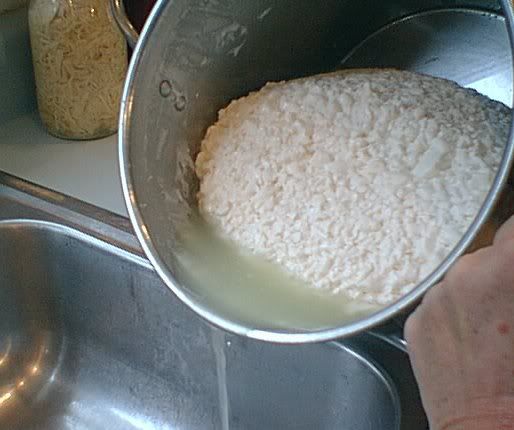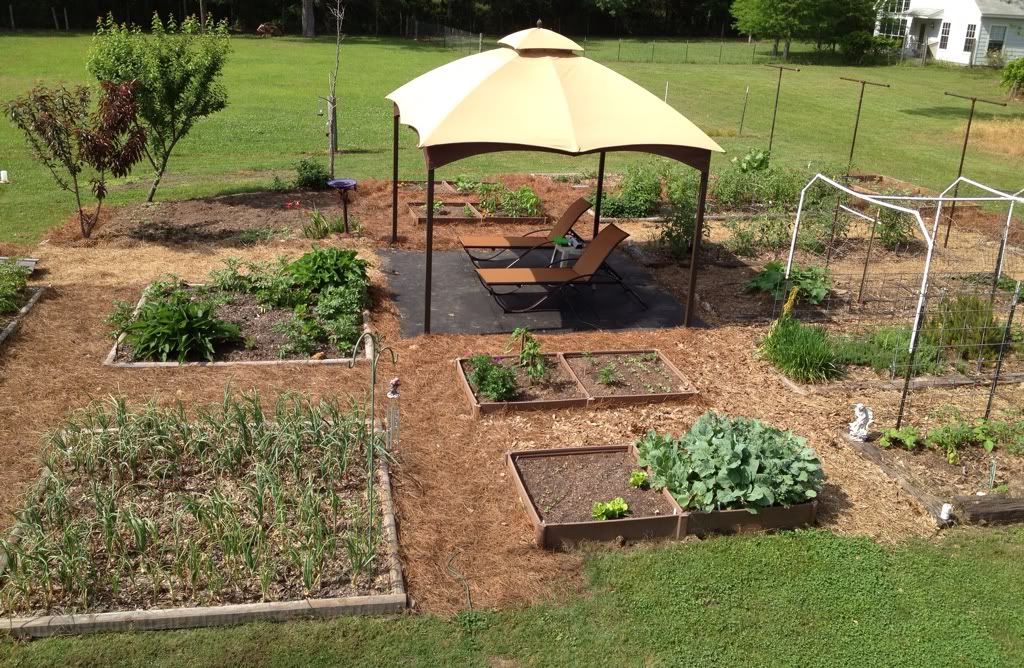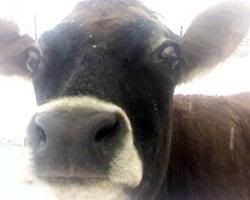Making cheese without the stress.
Dec 4, 2005 21:59:04 GMT -5
39chicks1cow, renee7008, and 5 more like this
Post by Deleted on Dec 4, 2005 21:59:04 GMT -5
One of the first things I discovered when I started making cheese was that there is more flexibility in the methods than the books tell you.
When it says "stir for 20 minutes" I found that I could stir - and run to the chicken house and get the eggs - and stir - and then, run to the garden and gather a bucket of tomatoes - and then stir and run to the end of the driveway and mail a letter and - then stir.
You can also sit on a bar stool and stir with one hand and hold a book with the other and read for 20 minutes.
But, you get the idea. Multi-tasking.
When I am making a particular cheese - say a cheddar or colby or gouda - something that has some particular requirements that will make it feel and taste like a cheddar, colby or gouda - I do the book reading thing, while stirring and timing.
More and more, though, I lean towards two particular cheeses that I make when my days are super busy.
This first one, I make on a moderately busy day:
I label it "Washed Curd" and that tells me which method I used for it.
I use however much milk Guernsey gave that morning.
Depending on how much I let the calf have, it is 1 1/2, 2, 2 1/2 or 3 gallons of milk.
I stir in 1/3 to 1/2 cup of culture, depending on how much milk. (No exactness needed here.) Or, use one packet of the Direct Set Dried Culture that you can buy.
A word about adding the culture that you have made. Years ago, I wondered why some cheeses did better than others and why some cottage cheeses didn't set up like they should have in 12 to 18 hours. Then once, as a fluke, I dipped a slotted spoon through some milk that I had added a half a cup of culture to and brought up a big glob of culture that had never broken up. Upon further investigation, I was able to retrieve, with the slotted spoon, most of the culture that I would have told you I had mixed in thoroughly.
Maybe everyone else had figured it out already, but I had only read "add and mix in the culture" - and thought I had done so. Ever since finding that culture in that milk, I have a little procedure that I do when I add the culture. I put it in the measuring cup and - while still in the measuring cup - I stir it up until there are no chunks and it is smooth and then add some milk and stir it up some more with that milk and then fill the cup up with milk and stir it thoroughly -- then I add it to my milk and stir it in thoroughly. That made a lot of difference in the taste and quality of my cheeses.
That said: Culture is in and now the milk can be set back and I go on to other things. I leave the milk for about an hour, but sometimes it can get to be 1 1/2 hour or even 2. Just depends on the day and the other projects. I add about 1/2 to 2/3 teaspoon of rennet (depending on how much milk) that has been diluted in 1/4 cup milk and mix it well for about 15 seconds.
I leave this sit for 45 minutes, or an hour or an hour and a half - again, depending on the day. I cut the curd in 1/2 inch to 3/4 inch cubes and leave it sit for 15 minutes or 30 minutes or in extreme cases, an hour. (I shoot for 15 minutes.) Then, I stir gently and bring up any big curds to cut them smaller. This step of stirring takes me 15 seconds, then I go on to other things. I stop back by when I can to give it a stir. Sometimes, every 15 minutes, sometimes every 30 minutes. Any family member who goes to the sink for a drink, knows to give the cheese a stir.
When the curds are starting to settle to the bottom between stirrings, I pour the whey off, down to the level of the curds and add warm water back to the original line where the milk had been and stir well.
I do this three to five times - draining off the whey and adding fresh, warm water and stirring. I do this "washing the curd" every 15 minutes, or every 30 minutes or even longer between when we are busy.
This cheese is in the making for as long as 6 to 7 hours or as quickly as 3 to 4 hours.
One last time, I drain the whey - all of it this time and add 3 to 4 tablespoons of salt. Sounds like a lot of salt and most other recipes call for 2 tablespoons for 2 gallons of milk. That said, the cheeses are never salty. You lose some of it in the whey that comes out in the press. (Your mileage may vary.)
From this step, it goes right in the press. I press one time with 40 to 50 pounds and for 18 to 24 hours. I remove from the press and from the cheesecloth and dry it in the cheese aging refrigerator for 1, 2, or 3 days.
Then I wax it. If any corner got a little dry while waiting for the waxing, I trim it off.
I used to try to dry outside the refrigerator, but have trouble with an occasional gnat.
I age the cheese for 90 days.
The beauty of this method is that every cheese is just a little different. All of them wonderful, but each unique. Each step in the making that got prolonged because I got side tracked causes variations in that cheese. Shorter or longer culturing stage, longer or shorter times between the rinses - it all changes the cheese one way or another.
My kids tease me about saying "This is the best one yet" about every cheese I open and taste. They say, "Mom, they can't all be the best one yet!" then, "Well, maybe you're right about this one."
Now, that's my washed curd cheese. Anyone can make it on any busy day. Culture, rennet, stir, drain, add water, drain, add water, drain, add water, drain, salt, and into the press. Dry, wax, age.
Pictures coming up.
homestead2
When it says "stir for 20 minutes" I found that I could stir - and run to the chicken house and get the eggs - and stir - and then, run to the garden and gather a bucket of tomatoes - and then stir and run to the end of the driveway and mail a letter and - then stir.
You can also sit on a bar stool and stir with one hand and hold a book with the other and read for 20 minutes.
But, you get the idea. Multi-tasking.
When I am making a particular cheese - say a cheddar or colby or gouda - something that has some particular requirements that will make it feel and taste like a cheddar, colby or gouda - I do the book reading thing, while stirring and timing.
More and more, though, I lean towards two particular cheeses that I make when my days are super busy.
This first one, I make on a moderately busy day:
I label it "Washed Curd" and that tells me which method I used for it.
I use however much milk Guernsey gave that morning.
Depending on how much I let the calf have, it is 1 1/2, 2, 2 1/2 or 3 gallons of milk.
I stir in 1/3 to 1/2 cup of culture, depending on how much milk. (No exactness needed here.) Or, use one packet of the Direct Set Dried Culture that you can buy.
A word about adding the culture that you have made. Years ago, I wondered why some cheeses did better than others and why some cottage cheeses didn't set up like they should have in 12 to 18 hours. Then once, as a fluke, I dipped a slotted spoon through some milk that I had added a half a cup of culture to and brought up a big glob of culture that had never broken up. Upon further investigation, I was able to retrieve, with the slotted spoon, most of the culture that I would have told you I had mixed in thoroughly.
Maybe everyone else had figured it out already, but I had only read "add and mix in the culture" - and thought I had done so. Ever since finding that culture in that milk, I have a little procedure that I do when I add the culture. I put it in the measuring cup and - while still in the measuring cup - I stir it up until there are no chunks and it is smooth and then add some milk and stir it up some more with that milk and then fill the cup up with milk and stir it thoroughly -- then I add it to my milk and stir it in thoroughly. That made a lot of difference in the taste and quality of my cheeses.
That said: Culture is in and now the milk can be set back and I go on to other things. I leave the milk for about an hour, but sometimes it can get to be 1 1/2 hour or even 2. Just depends on the day and the other projects. I add about 1/2 to 2/3 teaspoon of rennet (depending on how much milk) that has been diluted in 1/4 cup milk and mix it well for about 15 seconds.
I leave this sit for 45 minutes, or an hour or an hour and a half - again, depending on the day. I cut the curd in 1/2 inch to 3/4 inch cubes and leave it sit for 15 minutes or 30 minutes or in extreme cases, an hour. (I shoot for 15 minutes.) Then, I stir gently and bring up any big curds to cut them smaller. This step of stirring takes me 15 seconds, then I go on to other things. I stop back by when I can to give it a stir. Sometimes, every 15 minutes, sometimes every 30 minutes. Any family member who goes to the sink for a drink, knows to give the cheese a stir.
When the curds are starting to settle to the bottom between stirrings, I pour the whey off, down to the level of the curds and add warm water back to the original line where the milk had been and stir well.
I do this three to five times - draining off the whey and adding fresh, warm water and stirring. I do this "washing the curd" every 15 minutes, or every 30 minutes or even longer between when we are busy.
This cheese is in the making for as long as 6 to 7 hours or as quickly as 3 to 4 hours.
One last time, I drain the whey - all of it this time and add 3 to 4 tablespoons of salt. Sounds like a lot of salt and most other recipes call for 2 tablespoons for 2 gallons of milk. That said, the cheeses are never salty. You lose some of it in the whey that comes out in the press. (Your mileage may vary.)
From this step, it goes right in the press. I press one time with 40 to 50 pounds and for 18 to 24 hours. I remove from the press and from the cheesecloth and dry it in the cheese aging refrigerator for 1, 2, or 3 days.
Then I wax it. If any corner got a little dry while waiting for the waxing, I trim it off.
I used to try to dry outside the refrigerator, but have trouble with an occasional gnat.
I age the cheese for 90 days.
The beauty of this method is that every cheese is just a little different. All of them wonderful, but each unique. Each step in the making that got prolonged because I got side tracked causes variations in that cheese. Shorter or longer culturing stage, longer or shorter times between the rinses - it all changes the cheese one way or another.
My kids tease me about saying "This is the best one yet" about every cheese I open and taste. They say, "Mom, they can't all be the best one yet!" then, "Well, maybe you're right about this one."
Now, that's my washed curd cheese. Anyone can make it on any busy day. Culture, rennet, stir, drain, add water, drain, add water, drain, add water, drain, salt, and into the press. Dry, wax, age.
Pictures coming up.
homestead2









 and then the baby needs attention, and then-oh-Jesse's just let out both a rabbit-and the ferret!! and then whoops-back to the cheese-in between the phone rings a dozen times! Today I over ran the sink, all over the floor! Partially from not paying attention, (as usual!) and partly from Hubby unclogging the tap and not warning me-the amt of time it takes to fill the sink was cut in half!! So then I got on another tack-mopping the floor-which probably needed it anyways!! And yes, I'm a FLYbaby-but still a SHE! <smile>
and then the baby needs attention, and then-oh-Jesse's just let out both a rabbit-and the ferret!! and then whoops-back to the cheese-in between the phone rings a dozen times! Today I over ran the sink, all over the floor! Partially from not paying attention, (as usual!) and partly from Hubby unclogging the tap and not warning me-the amt of time it takes to fill the sink was cut in half!! So then I got on another tack-mopping the floor-which probably needed it anyways!! And yes, I'm a FLYbaby-but still a SHE! <smile>

 )
) Ahhh-life with a busy, curious, almost 3 yr old! <smile>!!
Ahhh-life with a busy, curious, almost 3 yr old! <smile>!!

